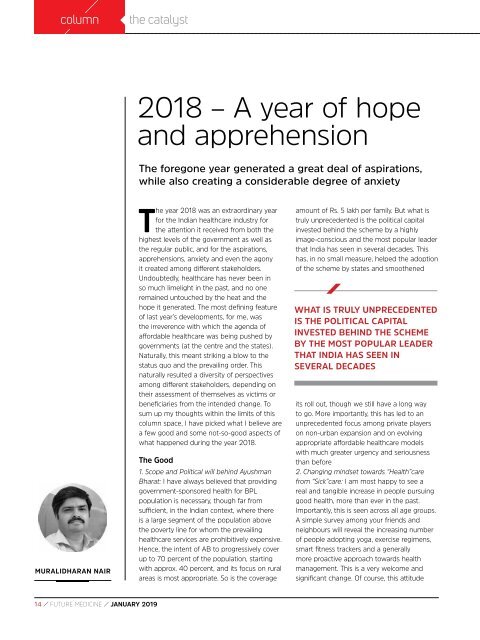FM JANUARY 2019 - digital edition
Create successful ePaper yourself
Turn your PDF publications into a flip-book with our unique Google optimized e-Paper software.
column<br />
the catalyst<br />
2018 – A year of hope<br />
and apprehension<br />
The foregone year generated a great deal of aspirations,<br />
while also creating a considerable degree of anxiety<br />
MURALIDHARAN NAIR<br />
The year 2018 was an extraordinary year<br />
for the Indian healthcare industry for<br />
the attention it received from both the<br />
highest levels of the government as well as<br />
the regular public, and for the aspirations,<br />
apprehensions, anxiety and even the agony<br />
it created among different stakeholders.<br />
Undoubtedly, healthcare has never been in<br />
so much limelight in the past, and no one<br />
remained untouched by the heat and the<br />
hope it generated. The most defining feature<br />
of last year’s developments, for me, was<br />
the irreverence with which the agenda of<br />
affordable healthcare was being pushed by<br />
governments (at the centre and the states).<br />
Naturally, this meant striking a blow to the<br />
status quo and the prevailing order. This<br />
naturally resulted a diversity of perspectives<br />
among different stakeholders, depending on<br />
their assessment of themselves as victims or<br />
beneficiaries from the intended change. To<br />
sum up my thoughts within the limits of this<br />
column space, I have picked what I believe are<br />
a few good and some not-so-good aspects of<br />
what happened during the year 2018.<br />
The Good<br />
1. Scope and Political will behind Ayushman<br />
Bharat: I have always believed that providing<br />
government-sponsored health for BPL<br />
population is necessary, though far from<br />
sufficient, in the Indian context, where there<br />
is a large segment of the population above<br />
the poverty line for whom the prevailing<br />
healthcare services are prohibitively expensive.<br />
Hence, the intent of AB to progressively cover<br />
up to 70 percent of the population, starting<br />
with approx. 40 percent, and its focus on rural<br />
areas is most appropriate. So is the coverage<br />
amount of Rs. 5 lakh per family. But what is<br />
truly unprecedented is the political capital<br />
invested behind the scheme by a highly<br />
image-conscious and the most popular leader<br />
that India has seen in several decades. This<br />
has, in no small measure, helped the adoption<br />
of the scheme by states and smoothened<br />
WHAT IS TRULY UNPRECEDENTED<br />
IS THE POLITICAL CAPITAL<br />
INVESTED BEHIND THE SCHEME<br />
BY THE MOST POPULAR LEADER<br />
THAT INDIA HAS SEEN IN<br />
SEVERAL DECADES<br />
its roll out, though we still have a long way<br />
to go. More importantly, this has led to an<br />
unprecedented focus among private players<br />
on non-urban expansion and on evolving<br />
appropriate affordable healthcare models<br />
with much greater urgency and seriousness<br />
than before<br />
2. Changing mindset towards “Health”care<br />
from “Sick”care: I am most happy to see a<br />
real and tangible increase in people pursuing<br />
good health, more than ever in the past.<br />
Importantly, this is seen across all age groups.<br />
A simple survey among your friends and<br />
neighbours will reveal the increasing number<br />
of people adopting yoga, exercise regimens,<br />
smart fitness trackers and a generally<br />
more proactive approach towards health<br />
management. This is a very welcome and<br />
significant change. Of course, this attitude<br />
14 / FUTURE MEDICINE / <strong>JANUARY</strong> <strong>2019</strong>


















